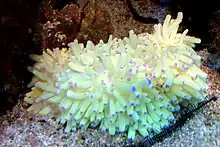Heteractis malu
Heteractis malu, also known as the malu anemone, delicate sea anemone[1] or white sand anemone, is a species of sea anemone in the family Stichodactylidae.[2]
| Heteractis malu | |
|---|---|
 | |
| Scientific classification | |
| Domain: | Eukaryota |
| Kingdom: | Animalia |
| Phylum: | Cnidaria |
| Class: | Hexacorallia |
| Order: | Actiniaria |
| Family: | Stichodactylidae |
| Genus: | Heteractis |
| Species: | H. malu |
| Binomial name | |
| Heteractis malu (Haddon and Shackleton, 1893) | |
| Synonyms | |
|
List
| |
Description
This anemone has stout, sparse tentacles, almost always under 40mm in length, usually tipped with magenta colouration. These tentacles vary in length, even among a single radial row.[1]
The column has a pale cream or yellow colouration, with patches of deep yellow or orange sometimes present. It remains buried in sediment up to the level of the oral disc.[1] The oral disc grows to a maximum diameter of 200 mm, is brown or purplish, possibly with a white, radial pattern. It may sometimes be bright green, but this is rare.[1]
This species is similar in appearance to Macrodactyla doreensis, Heteractis aurora, and Heteractis crispa. These species are also found burrowed into the sediment, and share the same red or yellow blotches. H. malu is primarily distinguished by its short sparse tentacles.[1]
Distribution
Heteractis malu occurs in scattered areas ranging from Japan in the north, to Australia in the south, east to the islands of Hawaii and west to Sumatra.[1]
The only anemonefish associated with this species is Clark's anemonefish (Amphiprion clarkii).[1] Sexually mature fish are rarely associated with H. malu, however the reason for this is unknown.[1] The relationship between anemonefish and their host sea anemones is highly nested in structure. The anemonefish is the active partner in establishing the interaction.[3] As the single hosted anemonefish, A. clarkii,[1] is the extreme generalist, it may be that H. malu is a marginal host tolerated only by the least selective fish and only when no other host is available.[3]
References
- Fautin, Daphne G.; Allen, Gerald R. (1997). Field Guide to Anemone Fishes and Their Host Sea Anemones. Western Australian Museum. ISBN 9780730983651. Archived from the original on 14 April 2015.
- Fautin DG, ed. (2015). "Heteractis malu (Haddon & Shackleton, 1893)". Hexacorallians of the World. World Register of Marine Species. Retrieved 9 October 2017.
- Ollerton J; McCollin D; Fautin DG; Allen GR. (2007). "Finding NEMO: nestedness engendered by mutualistic organization in anemonefish and their hosts". Proceedings of the Royal Society B: Biological Sciences. 274 (1609): 591–598. doi:10.1098/rspb.2006.3758. PMC 1766375. PMID 17476781.
External links
- "Heteractis malu". Integrated Taxonomic Information System.
- Heteractis malu. Haddon & Shackleton, 1893. Retrieved through: World Register of Marine Species.